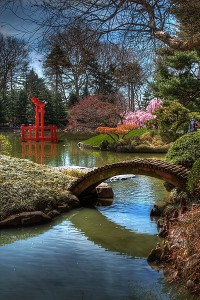Brooklyn is a beautiful and diverse utopia filled with unprecedented amounts of historical knowledge for such a small borough. Many from around the world come to visit this piece of the Metropolis (New York City) to experience its wonders, but for those who already live here, a break from the concrete jungle is sometimes much needed; this is where the Brooklyn Botanic Garden comes in. The Brooklyn Botanic Garden offers the sheer sensation of peace, while at the same time offering that historical knowledge that many seek, and it’s all here at the heart of Brooklyn. Inhabitants come to experience the cheerful nirvana that this sanctuary provokes, and not to mention the roots of history all around you. The garden combines knowledge and beauty into one hybrid that functions as a successful ecosystem, and this is especially thanks to its many exhibitions. For example, when you walk through the Cherry Blossom part of the garden, you feel as if you’re not in Brooklyn any more, you immerse yourself through all of your senses, you can see the beauty, smell the freshness of nature, you can hear the soft birds fly across as you pick up a Cherry Blossom petal of the ground and feel its softness; while at the same time you can read that these specific Cherry Blossom trees were given by Japan as a gift after World War 1 which makes experiencing it that much better and important. The Brooklyn Botanic Garden also features many activities and festivities such as teachings on agriculture, poem competitions, concerts, agricultural celebrations, and even weddings. As you can see, the garden is like the Madison Square Garden of the organic world offering entertainment in a different way. It is a place that started as a ash dump area, then ultimately bloomed into a divine sanctuary despite being in a a crowded and concrete area.  Since we have this magnificent place right in the heart of our beloved utopia that is Brooklyn, why not visit it?
Since we have this magnificent place right in the heart of our beloved utopia that is Brooklyn, why not visit it?
Categories
Tags
- Alan Trachtenberg
- BHS
- Brooklyn
- Brooklyn Bridge
- Brooklyn History
- Brooklyn Navy Yard
- computer labs
- cover letter
- EBSCO
- events
- feedback
- Google Maps
- homework
- images
- instructions
- Jennifer Egan
- Learning Center
- Learning Community
- librarian
- Library
- MLA
- persuasive speeches
- Phillip Lopate
- photographs
- presentation
- primary sources
- process
- questions
- readings
- reflection
- registration
- research
- research help
- Research Project
- revision
- SAFA
- syllabus
- thesis statements
- tours
- tutoring
- URL shortener
- voting
- walking
- workshops
- YouTube
-
Recent Posts
Recent Comments
Meta
Archives




